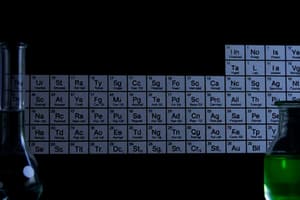Podcast
Questions and Answers
Identify the limiting component when assembling a bicycle with the given parts: 4 handle bars, 4 seats, 3 frames, 7 pedals, and 5 wheels.
Identify the limiting component when assembling a bicycle with the given parts: 4 handle bars, 4 seats, 3 frames, 7 pedals, and 5 wheels.
- Handle bar
- Pedals
- Frame (correct)
- Seat
How many oxygen atoms are present in 0.412 moles of Fe2O3?
How many oxygen atoms are present in 0.412 moles of Fe2O3?
- 2.48 x 10^23 oxygen atoms
- 7.44 x 10^23 oxygen atoms
- 4.96 x 10^23 oxygen atoms (correct)
- 2.48 x 10^24 oxygen atoms
Determine the mass of iron in grams of 7.24 x 10^22 iron atoms.
Determine the mass of iron in grams of 7.24 x 10^22 iron atoms.
- 0.120 g
- 1.30 x 10^21 g
- 465 g
- 6.71 g (correct)
What volume of solution (in L) is needed to make a 0.118 M solution when 22.4 g of CaCl2 is dissolved?
What volume of solution (in L) is needed to make a 0.118 M solution when 22.4 g of CaCl2 is dissolved?
Which substance is NOT soluble in water?
Which substance is NOT soluble in water?
Which of the following processes represents a chemical change?
Which of the following processes represents a chemical change?
What is the oxidation state of phosphorus in PO2+?
What is the oxidation state of phosphorus in PO2+?
How many neutrons are present in the isotope 37Cl?
How many neutrons are present in the isotope 37Cl?
Which is the correct molecular formula for a compound with an empirical formula of C2H2O and a molar mass of 210.20 g/mol?
Which is the correct molecular formula for a compound with an empirical formula of C2H2O and a molar mass of 210.20 g/mol?
What is the chemical name for Mg(ClO2)2?
What is the chemical name for Mg(ClO2)2?
What is the correct coefficient of O2 when balancing the equation NH3 (g) + O2 (g) → NO2 (g) + H2O (g)?
What is the correct coefficient of O2 when balancing the equation NH3 (g) + O2 (g) → NO2 (g) + H2O (g)?
Which of the following has the highest density in grams for water when measured in a room of given dimensions and density?
Which of the following has the highest density in grams for water when measured in a room of given dimensions and density?
Which of the following substances are considered non-electrolytes?
Which of the following substances are considered non-electrolytes?
Flashcards
Limiting Reactant
Limiting Reactant
The reactant that is completely consumed in a chemical reaction, thus limiting the amount of product that can be formed.
Avogadro's Constant
Avogadro's Constant
The number of atoms, molecules, or ions in one mole of a substance, approximately 6.022 × 10^23.
Molar Mass
Molar Mass
The mass of one mole of a substance, expressed in grams per mole (g/mol).
Molarity
Molarity
Signup and view all the flashcards
Solubility in Water
Solubility in Water
Signup and view all the flashcards
Balancing Chemical Equations
Balancing Chemical Equations
Signup and view all the flashcards
Stoichiometry
Stoichiometry
Signup and view all the flashcards
Mole Concept
Mole Concept
Signup and view all the flashcards
Calculating Theoretical Yield
Calculating Theoretical Yield
Signup and view all the flashcards
Conversion Factors
Conversion Factors
Signup and view all the flashcards
Significant Figures
Significant Figures
Signup and view all the flashcards
Chemical Change
Chemical Change
Signup and view all the flashcards
Magnesium Chlorite
Magnesium Chlorite
Signup and view all the flashcards
Number of Electrons in Cr+
Number of Electrons in Cr+
Signup and view all the flashcards
Number of Neutrons in 37Cl
Number of Neutrons in 37Cl
Signup and view all the flashcards
Empirical Formula
Empirical Formula
Signup and view all the flashcards
Molecular Formula
Molecular Formula
Signup and view all the flashcards
Oxidation State of Phosphorus in PO2+
Oxidation State of Phosphorus in PO2+
Signup and view all the flashcards
Non-Electrolyte
Non-Electrolyte
Signup and view all the flashcards
Study Notes
General Chemistry I - Midterm I
- Date: October 23, 2024
- Time: 3:30 PM - 4:20 PM
- Duration: 50 minutes
- Course: CHEM104-002/003
- Instructor: Dr. Vince Guo
- Materials: Test booklet (8 pages), Scantron sheet, spare paper, periodic table and constants, equations, pen, pencil, non-graphing calculators
Instructions
- Write name and student number on the test.
- Part A answers are in the designated space; answers elsewhere will not be graded.
- Underline final answers for Part A.
- Part B multiple choice answers on the Scantron sheet.
- Test is double-sided.
- Read questions carefully; answer only what is asked.
- Use pencil for Scantron.
- No extra time for filling in scantron.
- Cheating on the exam is serious academic misconduct and will be reported to the Associate Dean.
Part A - Short Answer Questions (10 points)
- Report final answers to correct significant figures and units.
- Show all calculation work for full marks.
Part B - Multiple Choice (40 points, 2 points each)
- All answers must be marked on a Scantron sheet.
- Complete questions 1-20 covering various chemistry concepts (chemical changes, chemical formulas, electron counts, neutron counts and calculations).
Additional Information
- Provide oxidation half reactions and activity series references for additional questions.
- The Periodic table and solubility rules are provided.
Studying That Suits You
Use AI to generate personalized quizzes and flashcards to suit your learning preferences.




